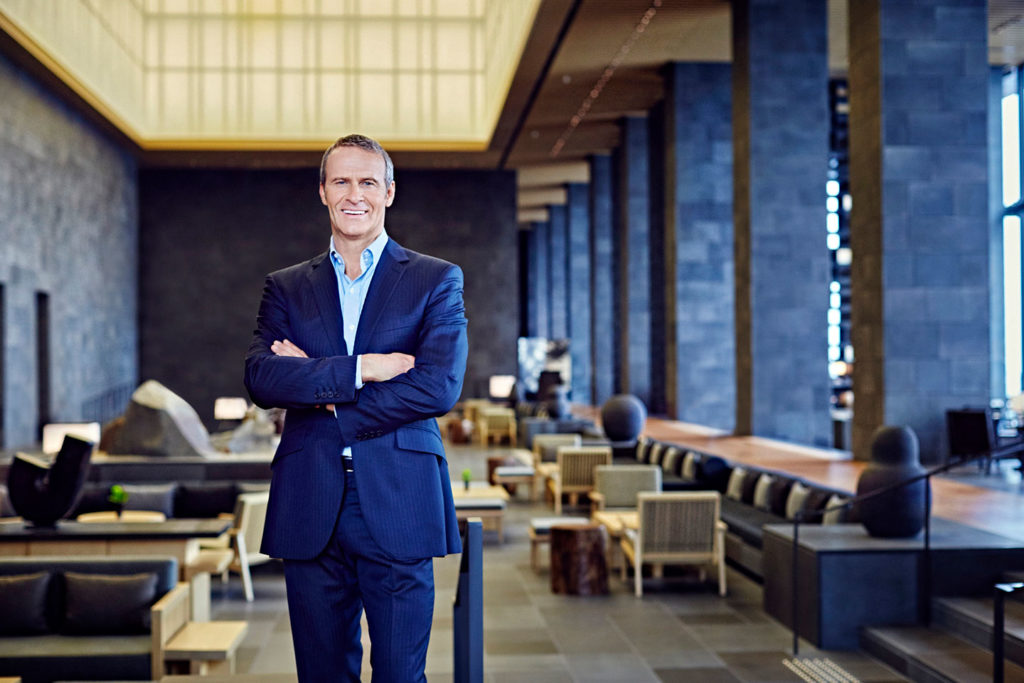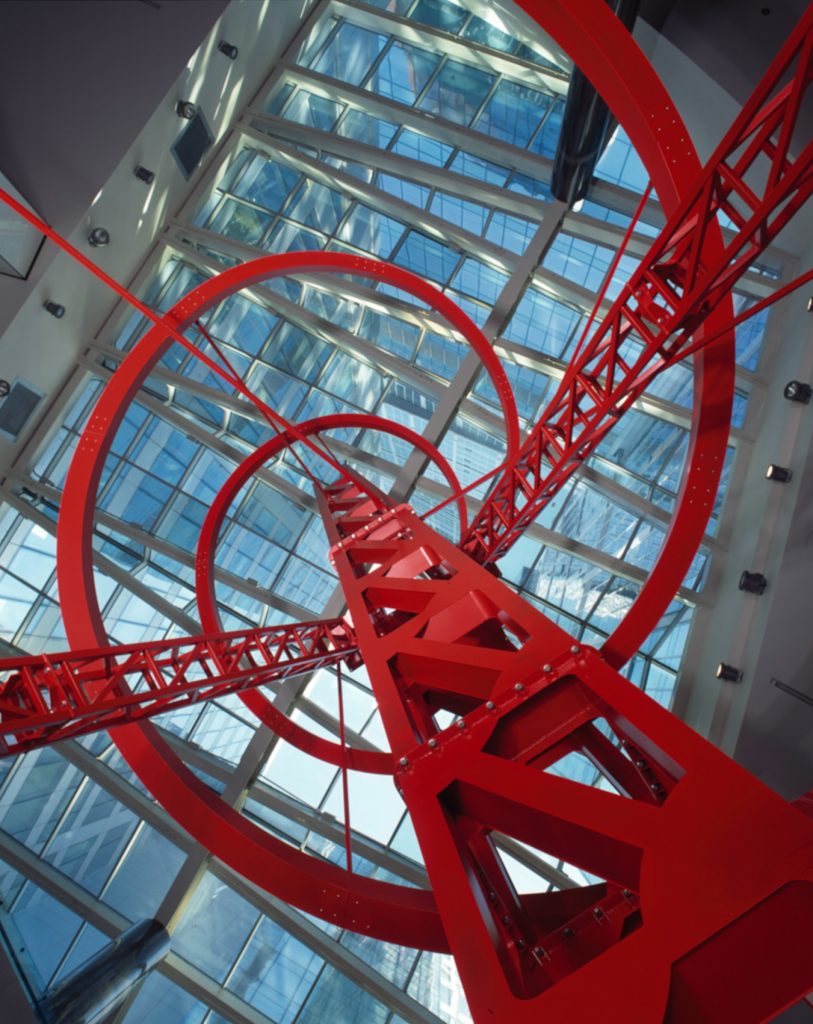
By Claire Wrathall | January 2019
Scan the walls of property magnate and Aman Resorts’ owner Vladislav Doronin’s four- storey penthouse atop one of the towers in the
Capital City development, high above Presnenskaya Eiribankirient in Moscow, and the art on the wails is the sort you might encounter in a museum.
There above one fireplace in the principal living space is Douglas Gordon’s smoke-and-mirror Portrait of You Me Jackie. Above the other is a captivating work by the Belgian conceptualist Arne Quinze, part of a series Intended, the artist has said. “to evoke archetypal houses as a parody of the way people live now [that] cities are running with inexhaustible fervour”. Parallel to the 2Om swimming pool is a long table by the Swiss-born, Brooklyn-based artist Urs Fischer, behind which hangs one of Julian Schnabel’s white-tarpaulin paintings. On the facing wall is a Jean-Michel Basquiat. IU a fraction of a collection that reads like a roll call of some of the most sought-after. most expensive names in the modern and contemporary canon: Salvador Dali, Anish Kapoor, Jeff Koons, Pablo Picasso, Frank Stella, Andy Warhol.
Ask Doronin what he’d save in a fire, however, and his answer is unexpected. “I’d probably say the El Lissitzky drawings and gouaches because they remind me of when I was young” he says. “I like all the art in my collection. That’s why I want to live with it But the El Lissitzky’s are the one thing I would not give up. They are what’s closest to me. I’m really attached to them.”
El Lissitzky, for those unfamiliar with the obscurer reaches of the Russian avant-garde, was an influential artist, graphic designer, photographer, polemicist and protégé of the great Kazimir Malevich, with whom he had studied in Vitebsk in the early 1920s.
Doronin grew up in Leningrad, now St Petersburg, in the 1970s, during the dark days of the Soviet Union, and his parents — his father, an economist, was director of the prestigious Academy of Sciences, his mother a university lecturer in literature — were regular visitors to the city’s great repositories of art and keen to educate him. “Every Saturday we would go to a different museum,” he recalls, not least the Hermitage, and when they went to Moscow: the Tretyakov.
Over time he acquired a knowledge of art, especially the great masters of 19th-century Russian painting. He reels off a list of names: the marine artist Ivan Aivazovsky (a painting by whom his family owned), the landscape painters Ivan Shishkin, Julius von Klever… But the first artist whose work really spoke to him was Malevich, a radically innovative artist, founder of Suprematism, a movement that championed an early form of abstract art characterised by simple geometric forms — squares, circles, triangles — and a limited palette of striking colours, the most extreme example of which was the Black Square he painted in 1915. “Why?” he exclaims. “Because it was avant-garde! And it was Russian!”
“I was still at school, I was 16, so I didn’t have any money” — Doronin began to search for Suprematist artworks, which had been banned by Stalin but could be bought cheaply if you could find them. “Back then they were affordable,” he says. “They did not have the prices they have now.” And over time he acquired works on paper by many of Malevich’s most accomplished disciples: El Lissitzky, Nikolai Suetin, Vladimir and Georgii Stenberg and Alexandra Ekster. “She designed a lot for Russian ballet, decor and costumes,” he says about the latter. ‘Very nice drawings.” He also found an oil painting by Liubov Popova, whose works can now realise seven- figure sums. “Of course, I was always dreaming one day to buy something by Malevich,” he continues. “One came up for sale at Christie’s last summer.” He leaves the sentence hanging (Entitled Suprematist Composition and painted in 1916, it sold for $85.8 million.) “anyway, that is how I started to collect art. If I’d known what would happen to the prices, I’d have bought more. But at that time In Russia you never thought to sell. There was basically no market I bought them because I liked them.”
It wasn’t until the beginning of this century, however, by which time Doronin had completed his first major residential project in Moscow, named Flagman, and was making serious money, that he began to collect in earnest. “At that time everyone was still talking about Impressionism. And Picasso. And Dali. And like everybody, that was what I started with. But I went to exhibitions, to galleries and museums, and I liked the style of Pop Art. So that’s what I decided to concentrate on.” Not exclusively, though. He continues to buy Russian works, and recently acquired a collection of nearly 1,000 Russian film posters printed between 1911 to 1930 from a family in the US, and a holding rivalled only by the one in the Russian Museum in St Petersburg.
Through his philanthropic foundation, he also supports promising art students, enabling them to study in London and New York, as well as a number of Russian artists who are not yet well known in the West — among them Oksana Mas, the Recycle Group, Mikhail Rozanov and Edward Schteinberg – not simply by buying their work but arranging exhibitions, both ln public spaces and In the lobbies of his building. The foundation also supports and works closely with institutions such as the unfailingly interesting Multimedia Art Museum Moscow and Gallery Aidan, the time contemporary-art gallery in Moscow. “Russians don’t know how to promote themselves,” he says “It’s not in our culture. We’re very closed. To enter the international arena, you need to work with a gallery. You need promotion, investment. And this has never happened. There was no one behind them. But look at our history,” he says. And the conversation tums to just how many great artists Russia produced in the 2Oth century: Kandinsky, Chagall, Rothko. “Many talented people. But artists need help.”
As to what he decides to buy, “it’s important to be educated,” he says, alluding to the due diligence he does before he buys a work of art. He buys at auction as well as from galleries, at fairs and privately from other collectors. “But the most important thing is that I like it. I appreciate it. I want to put it on my walls. Of course, it’s an investment. But I don’t like the Idea of people buying art just to put it in storage, though unfortunately that is sometimes necessary.”
It tells you something about the size of his collection that even with six substantial homes he hasn’t the wall space to accommodate it all. “I probably need to build more private houses,” he laughs. But then he takes architecture and the interior design of his homes very seriously indeed. He likens it “to putting clothing on my children. It grows with you, and you want it to live after you.” So the art needs to fit.
His Moscow apartment, for instance, was designed by Massimo losa Ghini, pioneer of the Bolidist Movement and once a member of Ettore Sottsass’s fabled Memphis Group. (The tower itself, one of eight major developments Doronin has masterminded in the Russian capital, was designed by the US architectural practice Skidmore Owings & Merrill. “I was the first to bring Western architects to Russia,” he adds. “I had big difficulties with the authorities over that.”) While his country house in the Barvikha Forest, just west of Moscow, is the work of Zaha Hadid, the only private house she designed before her life was cut short in 2016.
“Actually, Suprematism was a topic I discussed with Zaha the first time we met in London,” he recalls. “She told me she did her graduation project on Malevich’s Tektonik She was a big fan of Malevich and loved Suprematism. She liked that I collected it. So she agreed. She could have said no. She refused many customers. She was actually quite special like that. She was an architect of the next century. Not of the present. She lived in the future.”
The first project he planned to collaborate with her on, a huge development with an area of 78,000 square meters, failed to get planning consent. “Even with my connections, we couldn’t get permission,” he says, all incredulous. “But I still wanted to do a building with her, so I decided to ask her to design my private house. I met her for lunch, showed her some photographs of the site. I said, I want to see blue sky when I wake up in the morning, and the tops of the trees. And I don’t want to see any neighbours. So she said, we’ll have to go above the trees. She took a napkin, made a sketch, I looked at it and said: I like it. Go ahead. And that is how we started to work It was not easy to build. Everything had to be custom made.” The result is a house in which the master bedroom floats 30metres above the ground, balanced on a slender tower that rises out of the main structure.
It is a structure every bit as extraordinary and revolutionary as the vast, spiralling 400m-high tower Vladimir Tatlin proposed in 1919. It was never built, and none of the models survived. But in 2006, Doronin commissioned a scaled-down version — still a lofty 25m high — for the atrium of the shopping mall in the Capital City development, and there it stands, like the original intended, a monument not just to Suprematism, but to radical design and ambition.

